MusicRadar Verdict
A flexible, powerful drum machine that has a lot to offer for the price, only slightly held back by some clunky design choices.
Pros
- +
Versatile sound that blends analogue drums, samples and digital synthesis.
- +
Highly customisable with user samples and open-source synth and effect SDK.
- +
Per-step randomisation and parameter automation.
Cons
- -
Compact hardware means a lot of functionality is hidden behind shift presses or menus.
- -
Several instruments share front panel controls.
- -
Multi-engine can’t be played chromatically (but can be sequenced internally at different pitches).
MusicRadar's got your back
Korg Drumlogue: What is it?
First announced in January 2021, Drumlogue is a – by now eagerly awaited – percussion-focused addition to Korg’s popular Minilogue, Minilogue XD and Monologue.
On paper, there’s certainly a lot that appears exciting about the Drumlogue. This is a hybrid drum machine that combines analogue percussion synths with a multi-track sample engine and ‘Multi-Engine’, which is an open-source digital oscillator that can be updated with custom synths and effects. Now that we finally have our hands on one, does it live up to the hype?
We were slightly surprised by how small it is in the flesh. While none of the other instruments in the range are massive, per-se, they’re all substantial, with a decent crop of controls spread out across spacious interfaces. Earlier photos hinted at a Monologue-sized affair, but in reality, it’s broaching ‘mini synth’ territory.

While some will undoubtedly appreciate how compact it is, we're not sure that being the smallest in the range does the Drumlogue any favours. In fact – and let’s get this out of the way early – we're not a huge fan of the hardware in general. That reduced size means that a lot of features here are hidden behind multi-page menus and shift presses – some of which are slightly clumsily implemented. Compounding this is the choice of a mostly black design, labelled with small writing in white and grey – the latter used for shift functions that become virtually unreadable in anything other than bright, direct light. The buttons fare better, being backlit, and the bright screen helps considerably.
It performs a lot better on the connectivity front though. Along the rear panel, we get six individual, routable outputs plus a headphone output. These are accompanied by an audio input, analogue sync input and output, MIDI in and out, and two USB ports – one for connection to a DAW, and a second for connecting a USB MIDI device.
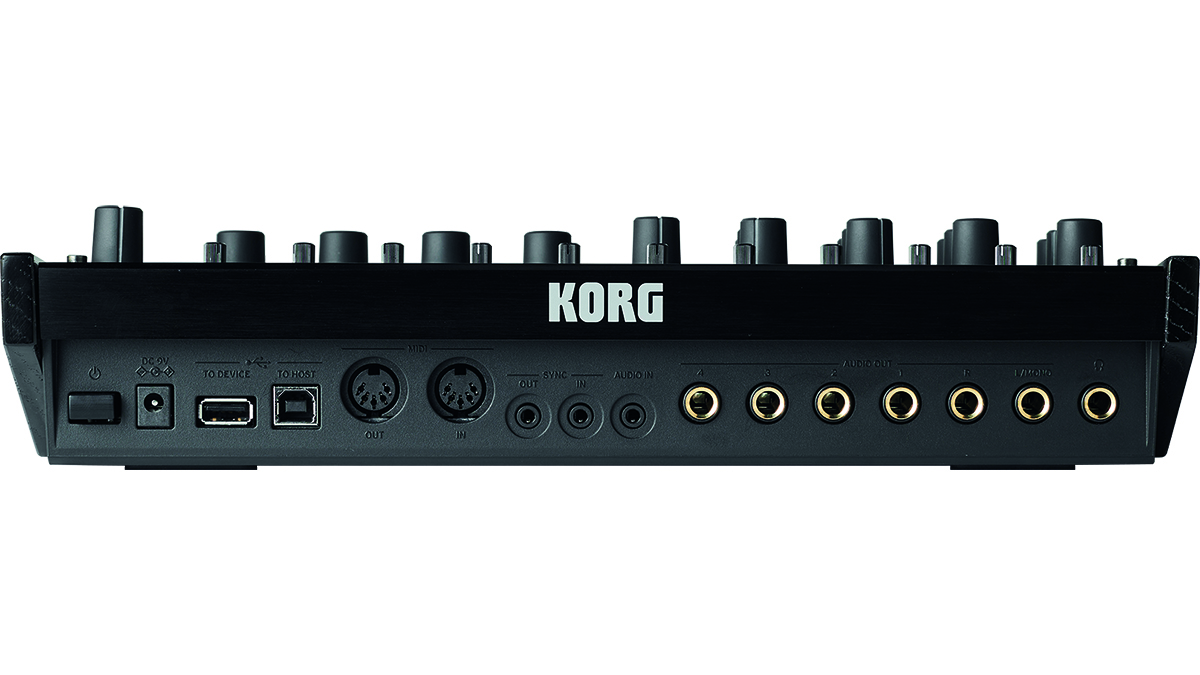
Korg Drumlogue: Performance and verdict
Control-wise, the key sound shaping parameters use the same rotaries found on the Mini/Monologues, which are solid and sizable, but track volume levels and tempo control are relegated to fiddly, Volca-style controls. A row of buttons along the lower edge of the unit acts as sound trigger and step-sequencing controls, but these are shallow and clicky, lacking the satisfying heft of sequencers on rival machines from the likes of Roland, Arturia or Behringer.
It’s worth getting these criticisms out of the way early because beyond these qualms there’s a lot to love about the Drumlogue. Firstly, the versatility of sound – scanning through the stock programs (presets that combine a drum kit and pre-made pattern) it quickly becomes clear how many styles Drumlogue can turn its hand to. These programs do a solid approximation of everything from Drexciya-style electro to moody big-room techno, skippy UK garage, chilled lo-fi, ’90s IDM and more.
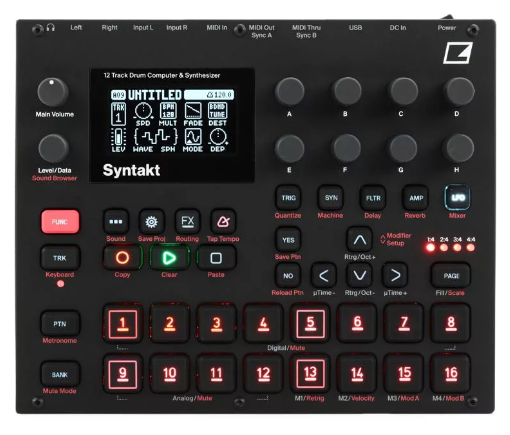
• Elektron Syntakt
Syntakt’s analogue and digital synthesis capabilities are more versatile, although it lands at a higher price point.
• Roland TR-8S
Roland’s drum machine similarly blends samples and synthesis, albeit with virtual analogue rather than the real thing. Its larger size is better for hands-on performance tasks.
• Novation Circuit Tracks
More comprehensive when it comes to digital synthesis, but more lightweight on the drum side, Circuit Tracks is nevertheless a great all-round groovebox.
Key to this versatility is the balance of analogue and digital sound sources. The analogue section consists of bass, snare, low and high toms. Each of these has a fairly minimal array of front panel controls (the toms share a single set), consisting of decay and tuning, plus a third parameter that varies between each – drive for the bass drum, ‘snap’ decay for the snare, and detune for the toms.
The full extent of sound shaping available goes much deeper than this though, with a range of settings available via the controls under Drumlogue’s screen. Using these it’s possible to, for example, shape the pitch sweep of the bass drum, apply bi-directional resonant filters and increase the attack punch of each sound. These analogue generators actually use a hybrid approach to sound creation, allowing users to blend a sampled attack sound over the top of the main analogue body, which can do a lot to alter the character of each drum sound and add extra punch.
The digital section, meanwhile, consists of open and closed hats, rim shot, clap and two generic sample slots. Again, front panel control is pretty minimal – just decay length for the hats and clap, and shared attack, decay and tuning controls for the sample tracks – but as with the analogue elements, there’s a lot more to tweak under the hood. This includes selecting the source sample, adjusting tuning, control over attack or release times (depending on which track is selected) and filtering. Users can also apply drive and bitcrushing effects to sampled sounds.
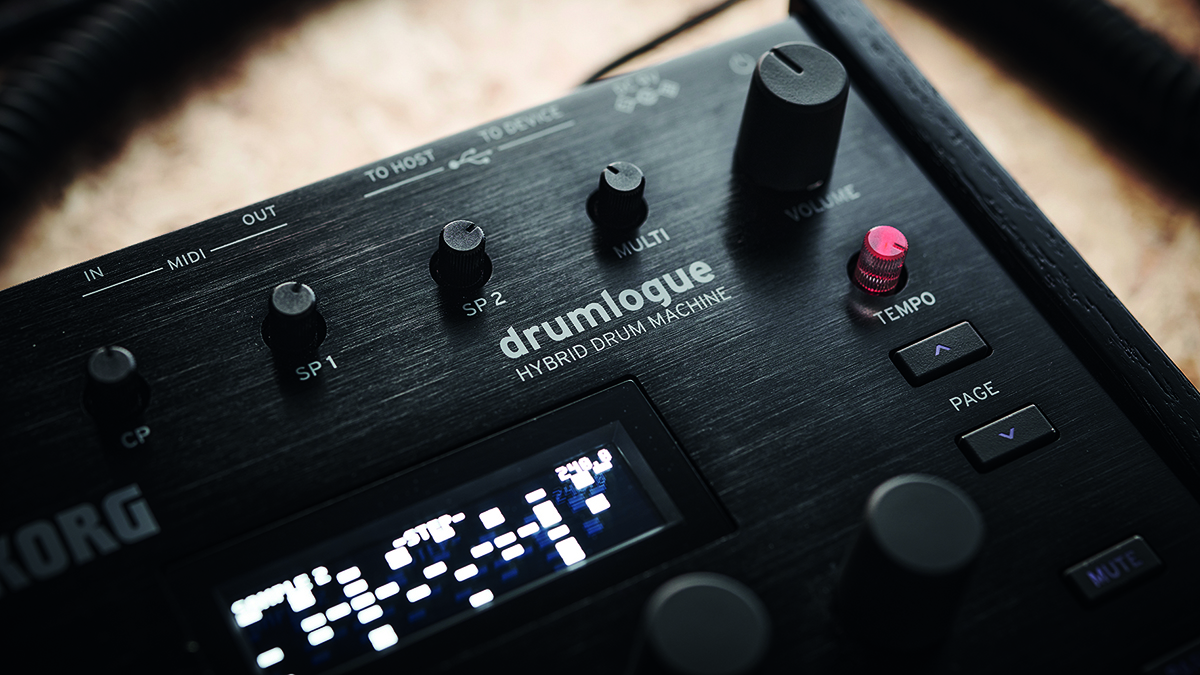
The final sound creation element is the Multi-Engine, which has three modes. The first of these is a VPM – variable phase modulation – engine. VPM sits in a similar sonic ballpark to FM synthesis or phase distortion. Here, it’s deployed through an array of seven presets, each of which can be adjusted using controls to adjust the amount and ratio of phase modulation, as well as by altering the amp envelope and filter cutoff.
The second mode here is a noise generator, with seven types of filtered noise available, plus controls to adjust the frequency and resonance of the filtering, plus attack and release.
The third Multi-Engine mode is a user mode, which can host sound generators created with the open-source SDK. By default, Drumlogue ships with Sinevibes’ Nano synth in this slot, which is a dual oscillator digital synth that’s particularly great for making rhythmic pulses and pitched percussion.
There’s a lot to really like here in terms of versatility and functionality
Drumlogue also has a trio of digital effect slots, comprising delay and reverb sends, each with presets and control over timing and character, along with a master effect section. The instrument ships with four master effects – a compressor, filter, boost/saturation and a three-band EQ.
However, as with the Multi-Engine, the selection of master effects can be augmented with effects created using the open SDK. This opens up some tantalising possibilities to go beyond the rather conventional remit of the four stock effects. Drumlogue allows users to route individual tracks to bypass the master effect, as well as apply any as a sidechain input, which offers a lot of potential for wild and rhythmic effect treatments.
Drumlogue’s sequencing workflow is flexible too, although, again, much of it is hidden within menus. Sequences can be up to 64 steps in length, with a variety of timing settings including the ability to set the sequencer to playback in a triplet rhythm. For swing and groove, Drumlogue uses global groove templates as opposed to a single swing parameter.
These templates include typical eight and 16-note swing, plus others based on typical conga, tambourine and agogo grooves, Baile funk, syncopated rhythms and more. Each template applies both velocity and timing, the emphasis of which can be increased in positive or negative directions. You can also apply different grooves to each sequencer track, as well as set individual step lengths for each sequencer track – although doing so requires shift pressing multiple buttons and isn’t very well labelled.
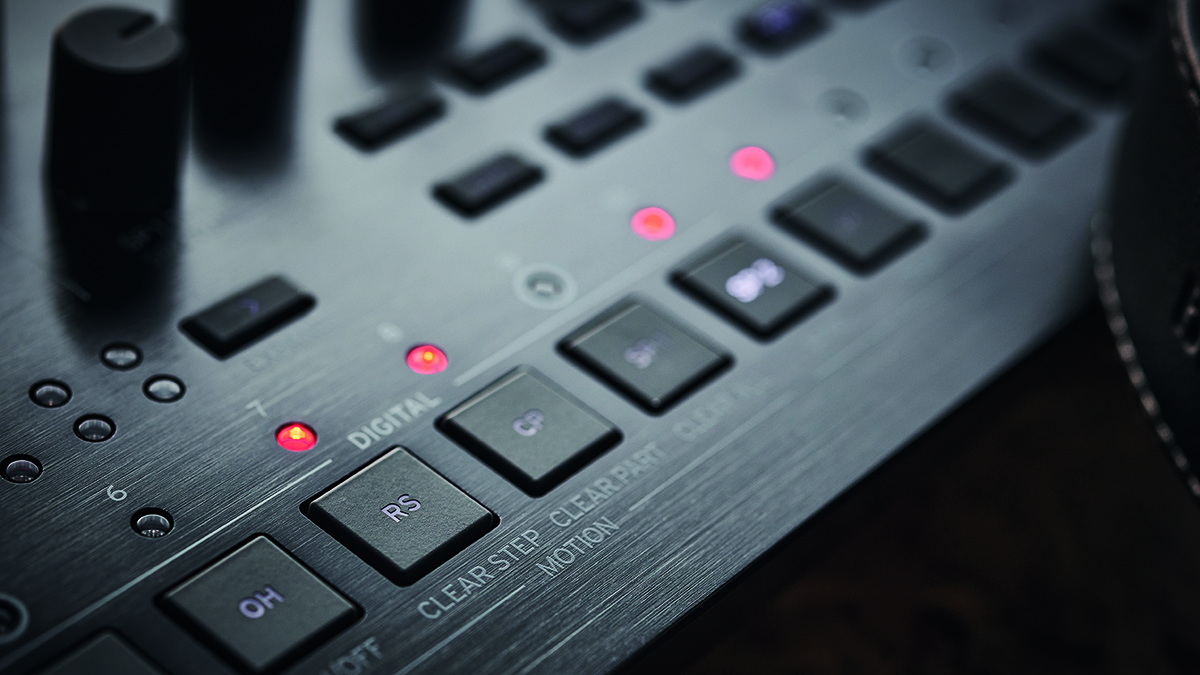
Each sequencer step can be assigned a probability for its trigger and – in Elektron-like style – each can be set to trigger only on certain alternate repeats of the sequence. Drumlogue also offers extensive automation sequencing, dubbed Motion Sequencing here as on other Korg instruments, although, unlike its counterparts, Drumlogue isn’t limited to a set number of automation tracks, offering full automation of every sound parameter. This is particularly handy for sequencing the Multi-Engine synths or pitched percussion samples, allowing Drumlogue to sequence melodic patterns and bass parts.
It’s a shame, however, that the synth engine can’t be played chromatically, either from the front panel or an external controller – an odd oversight, given the inclusion of the secondary USB port that appears tailor-made for a MIDI keyboard.
Beyond the loop stage, Drumlogue has a comprehensive chain function that lets users sequence up to 16 programs end-to-end, allowing automatic switching of both patterns and drum kits. There’s also a fun loop function, that lets users loop selected sequencer steps, allowing for the creation of stutters and turnarounds.
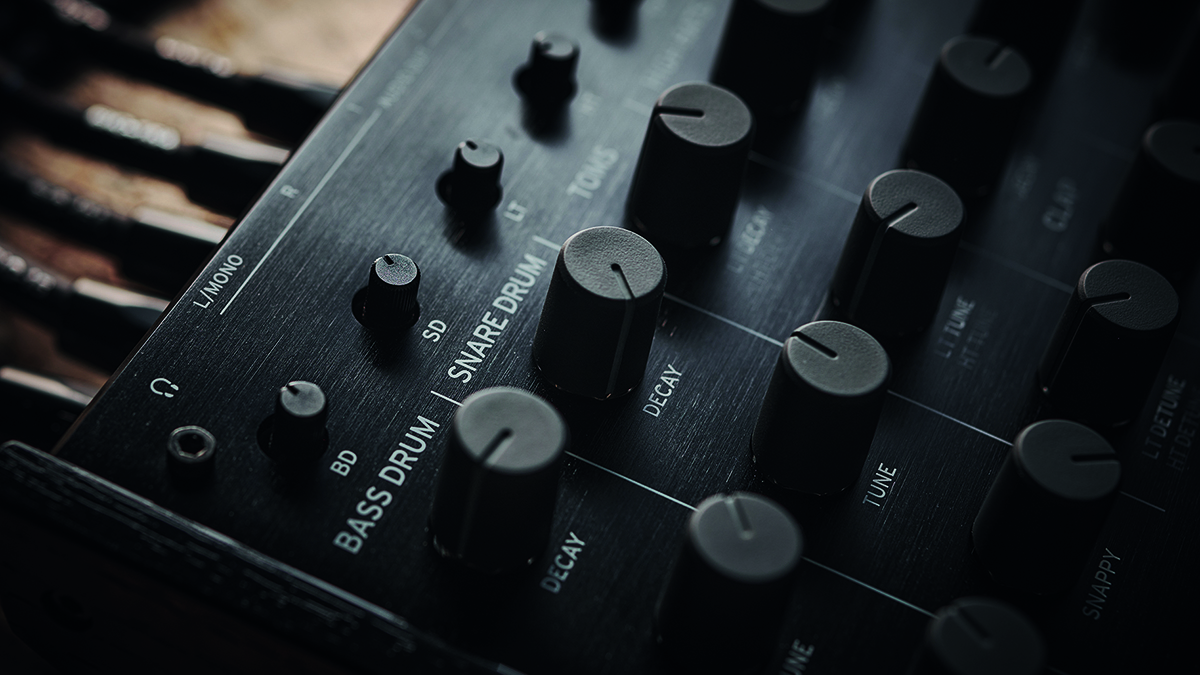
There’s a lot of versatility then, although, as noted, elements of the workflow remain clunky. The high tom is a prime example – it shares front panel controls with the low tom, meaning users need to hold shift to make adjustments. However, since the sequencer steps double up functionally via shift presses themselves, if you don’t remember to let go of shift before auditioning the sound, you’ll accidentally trigger the low tom step’s secondary function – which clears the current track. This makes it far too easy to accidentally delete an element of your current sequence while trying to adjust the tom’s sound.
The mute function is a little annoying too, as it requires users to always hold ‘mute’ while selecting tracks, which makes it harder to mute/unmute multiple tracks at once. There’s no solo function either, which limits the functionality when it comes to jamming on stage or in the studio.
We suspect that none of these drawbacks are likely to stand in the way of Drumlogue becoming a popular drum machine. There’s a lot to really like here in terms of versatility and functionality, particularly given the price point, but the hardware just holds it back from being an unequivocal success.
MusicRadar verdict: A flexible, powerful drum machine that has a lot to offer for the price, only slightly held back by some clunky design choices.
Korg Drumlogue: The web says
"The Korg drumlogue is a truly well thought-out and versatile drum machine and synthesizer that can absolutely hold its own against some much more expensive competitors."
Gearnews
Korg Drumlogue: Hands-on demos
Korg
loopop
BoBeats
Accurate Beats
Korg Drumlogue: Specifications
- KEY FEATURES: 11-track drum machine with four analogue channels, six digital sample channels and one customisable ‘Multi-Engine’. Also features audio input, three effect slots (delay, reverb, master effects), 64-step sequencer with full parameter automation.
- CONTACT: Korg
I'm the Managing Editor of Music Technology at MusicRadar and former Editor-in-Chief of Future Music, Computer Music and Electronic Musician. I've been messing around with music tech in various forms for over two decades. I've also spent the last 10 years forgetting how to play guitar. Find me in the chillout room at raves complaining that it's past my bedtime.
Brace yourself: Bryan Adams didn’t buy his first real six-string in a five and dime
“Nobody listens to one genre. I literally don’t know anybody who listens to one genre. You can be a fan of so many different artists at once”: Laufey on what Gen Z can teach the rest of us about how to appreciate music
Bon Iver - ranked: from Sable, Fable to For Emma, Forever Ago










